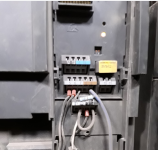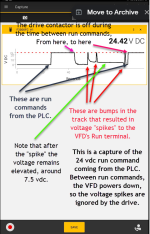AutomationTechBrian
Lifetime Supporting Member
I don't know what to think about this...
When a "finger car" travels over a bump, there is a spike in the output Q1.3 (24 vdc output). I've captured it with a Fluke trending app. (see pic) The output should not have the spikes in between the longer 24 v sections. In addition, instead of going back to 0, it hovers around 7 vdc for a while.
This output is for a run command on a VFD. I can defeat the false run commands by programming a permissive on another VFD terminal. But I'm concerned about the possibility that the PLC output is going bad. The I/O is not separate from the CPU, and this is an obsolete PLC.
Do you guys have any thoughts on this? Should we be worried about the PLC failing? Have you experienced this?
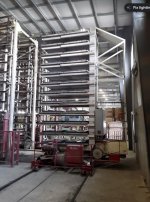
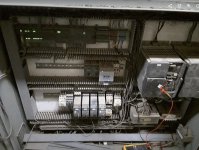
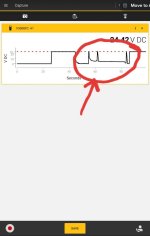
When a "finger car" travels over a bump, there is a spike in the output Q1.3 (24 vdc output). I've captured it with a Fluke trending app. (see pic) The output should not have the spikes in between the longer 24 v sections. In addition, instead of going back to 0, it hovers around 7 vdc for a while.
This output is for a run command on a VFD. I can defeat the false run commands by programming a permissive on another VFD terminal. But I'm concerned about the possibility that the PLC output is going bad. The I/O is not separate from the CPU, and this is an obsolete PLC.
Do you guys have any thoughts on this? Should we be worried about the PLC failing? Have you experienced this?








